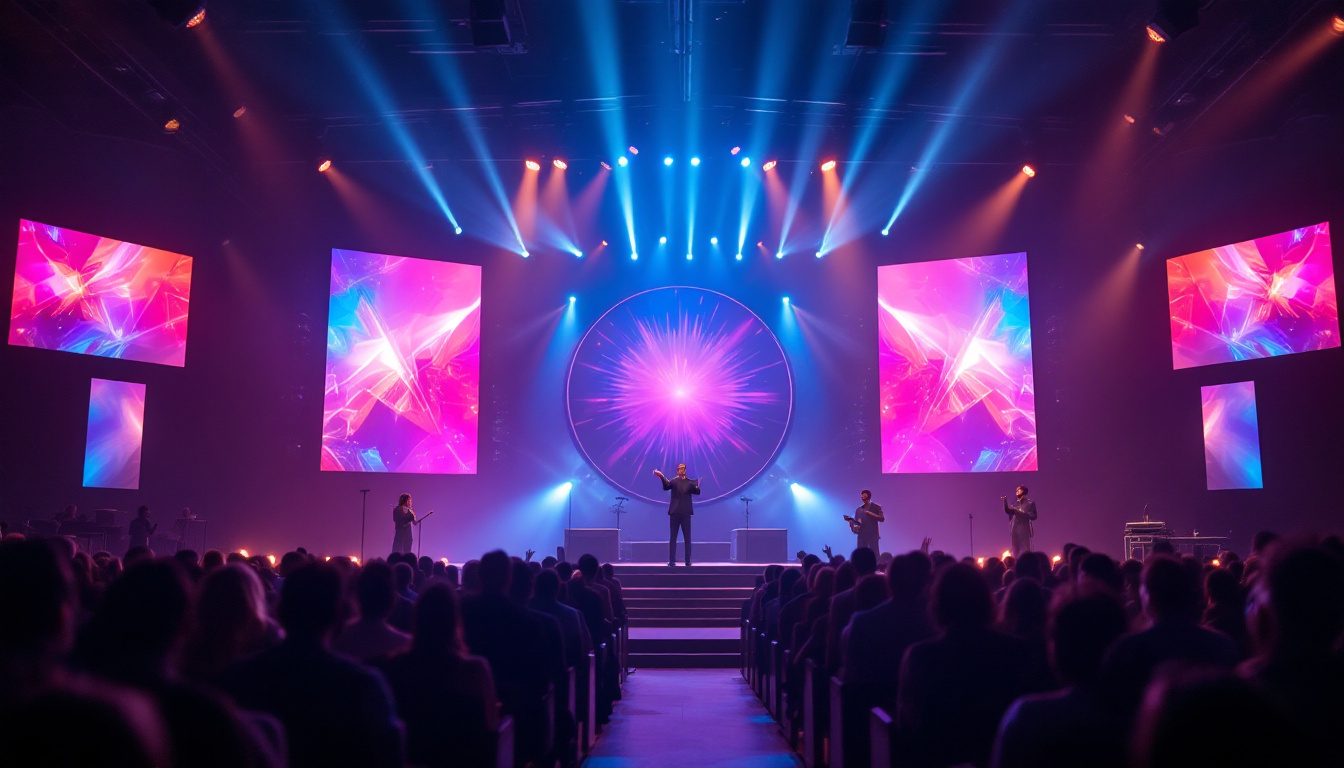In the modern age, churches are increasingly embracing technology to enhance the worship experience. One of the most impactful tools available is the large screen monitor, particularly LED displays. These screens not only serve practical purposes but also create an engaging atmosphere for congregants. This article delves into the benefits, types, and considerations for selecting large screen monitors for churches.
The Importance of Large Screen Monitors in Worship Settings
Large screen monitors have become a staple in many churches, transforming how services are conducted. They facilitate better communication, enhance engagement, and create a more immersive worship experience. By displaying lyrics, sermon notes, and multimedia content, these screens help congregants connect more deeply with the message being delivered.
Enhancing Engagement
One of the primary benefits of large screen monitors is their ability to enhance engagement. Traditional hymnals and printed materials can sometimes be cumbersome, especially in larger congregations. With LED displays, everyone can easily follow along, regardless of their seating position. This inclusivity fosters a sense of community and encourages participation in worship activities.
Moreover, the visual aspect of LED displays can capture attention in ways that printed materials cannot. dynamic presentations, videos, and images can be seamlessly integrated into the service, making the experience more memorable for attendees. This multimedia approach not only captivates but also reinforces the messages being shared. For instance, a powerful video testimony can evoke emotions and inspire congregants in ways that mere words might not achieve, creating a more profound connection to the themes being explored during the service.
Improving Communication
effective communication is crucial in any church setting. Large screen monitors can serve as powerful communication tools, displaying important announcements, upcoming events, and other relevant information. This ensures that congregants are well-informed and can participate actively in church life.
Additionally, during sermons, displaying key points or scripture references on the screen can help reinforce the pastor’s message. This dual approach—listening and seeing—can enhance understanding and retention of the information presented. Furthermore, large screens can also be utilized for interactive elements, such as live polls or Q&A sessions, allowing congregants to engage with the message in real-time. This not only enriches the worship experience but also empowers the congregation to voice their thoughts and questions, fostering a more dynamic and participatory environment.
In addition to enhancing communication during services, large screens can also play a pivotal role in community outreach and events. By showcasing images and videos from community service projects or mission trips, churches can inspire congregants to get involved and support various initiatives. These visual narratives can serve as a powerful reminder of the church’s mission and the impact it has on both the local and global community. As a result, large screen monitors become not just tools for communication, but vital instruments for fostering a sense of purpose and collective action within the church family.
Types of LED Displays for Churches
When it comes to selecting an LED display for a church, there are several types to consider. Each type has its unique features and advantages, making it essential to choose one that aligns with the church’s specific needs and budget.
Indoor LED Displays
Indoor LED displays are designed for use within church buildings. They are typically brighter and have higher resolution compared to outdoor displays, making them ideal for environments with controlled lighting. These screens can be mounted on walls or hung from ceilings, providing flexibility in placement.
Indoor displays are perfect for displaying song lyrics, sermon notes, and multimedia presentations during services. Their vibrant colors and sharp images can significantly enhance the worship experience, making it more engaging for congregants. Additionally, many indoor LED displays come equipped with advanced features such as touch-screen capabilities and interactive elements, allowing for a more immersive experience. This can be particularly beneficial during Bible study sessions or educational programs, where congregants can interact with the content being presented.
Outdoor LED Displays
For churches with outdoor services or events, outdoor LED displays are a valuable investment. These displays are built to withstand various weather conditions, ensuring durability and longevity. They are typically brighter than indoor displays, allowing for visibility even in direct sunlight.
Outdoor displays can be used for various purposes, from broadcasting services to displaying community announcements. They can also serve as a focal point during events or festivals, drawing in attendees and creating a vibrant atmosphere. Furthermore, many outdoor LED displays offer customizable content options, enabling churches to tailor their messages for specific audiences or occasions. This adaptability can help foster a sense of community by promoting local events, charity drives, or special services, ultimately enhancing the church’s outreach efforts.
Portable LED Displays
For churches that require flexibility, portable LED displays offer an excellent solution. These screens can be easily transported and set up in different locations, making them ideal for events, outreach programs, or even temporary services in various venues.
Portable displays often come with their own stands and can be connected to various devices for easy content sharing. This versatility allows churches to adapt to different environments and reach congregants wherever they may be. Additionally, many portable LED displays are designed with user-friendly interfaces, enabling church staff or volunteers to quickly learn how to operate them without extensive technical training. This ease of use can be particularly advantageous during busy events or when volunteers are managing the display, ensuring that the focus remains on the message being delivered rather than the technology itself. Moreover, some portable options are battery-operated, providing even greater flexibility for outdoor gatherings or locations without immediate access to power sources.
Key Considerations When Choosing LED Displays
Selecting the right LED display for a church involves several considerations. Understanding these factors can help ensure that the chosen display meets the needs of the congregation while staying within budget.
Size and Resolution
The size of the LED display is a critical factor. It should be large enough to be seen by all congregants, but not so large that it overwhelms the space. A common guideline is to choose a screen size based on the distance from which it will be viewed. For instance, a larger screen may be necessary for a church with a deep seating arrangement.
Resolution is equally important. Higher resolution displays provide clearer images and text, which is essential for readability during services. A display with at least 1080p resolution is recommended for indoor use, while outdoor displays may require even higher resolutions to ensure visibility in bright conditions.
Installation and Maintenance
Installation of LED displays can be a complex process, often requiring professional assistance. It is essential to consider the installation costs and the expertise of the team involved. Additionally, maintenance is a crucial aspect to keep in mind. Regular maintenance ensures the longevity of the display and optimal performance over time.
Churches should inquire about warranty options and support services offered by the manufacturer. A reliable support system can make a significant difference in addressing any issues that may arise post-installation.
Budget Considerations
Budget is always a significant consideration when investing in technology. LED displays come in a wide range of prices, depending on size, resolution, and features. It is essential to establish a budget that aligns with the church’s financial capabilities while also considering the long-term benefits of the investment.
Churches may also explore financing options or grants that can help alleviate the financial burden of purchasing large screen monitors. Investing in quality displays can enhance the worship experience, making it a worthwhile expenditure in the long run.
Best Practices for Using LED Displays in Churches
Once a church has invested in LED displays, implementing best practices can maximize their effectiveness. Proper usage can enhance the worship experience and ensure that the technology serves its intended purpose.
Content Planning
Content is king when it comes to LED displays. Planning and curating content ahead of time can make a significant difference in how effectively the screens are utilized. This includes selecting appropriate visuals, videos, and text that align with the service theme and message.
It is also essential to ensure that the content is updated regularly. Keeping the displays fresh and relevant can maintain congregants’ interest and engagement. Incorporating feedback from the congregation can also help tailor content to their preferences.
Training Staff and Volunteers
To ensure smooth operation, training staff and volunteers on how to use the LED displays is crucial. Familiarizing them with the technology can prevent technical issues during services and allow for seamless transitions between different types of content.
Regular training sessions can help keep everyone updated on new features or changes in the system. This investment in training can lead to a more professional and polished presentation during services.
Monitoring and Evaluation
Monitoring the effectiveness of the LED displays is essential for continuous improvement. Gathering feedback from congregants about their experience can provide valuable insights into what works well and what may need adjustment.
Evaluating the impact of the displays on engagement and participation can also guide future content decisions and technology investments. By regularly assessing the effectiveness of the displays, churches can ensure that they are meeting their goals and enhancing the worship experience.
Conclusion
Large screen monitors, particularly LED displays, have the potential to transform the worship experience in churches. By enhancing engagement, improving communication, and providing dynamic content, these displays can create a more immersive and inclusive environment for congregants.
When selecting an LED display, it is essential to consider factors such as size, resolution, installation, and budget. By following best practices for content planning, staff training, and monitoring, churches can maximize the benefits of their investment in technology.
As technology continues to evolve, embracing tools like LED displays can help churches connect with their congregations in meaningful ways, fostering a vibrant and engaging worship experience for all.
Discover LumenMatrix LED Solutions for Your Church
Ready to elevate your worship experience with cutting-edge LED display technology? LumenMatrix specializes in a wide array of LED solutions tailored to meet the needs of any church setting. From vibrant indoor and outdoor displays to innovative custom configurations, our products are designed to engage your congregation and bring your message to life. Check out LumenMatrix LED Display Solutions today and transform your worship services into immersive visual journeys.































